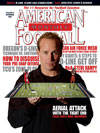AMERICAN FOOTBALL MONTHLY THE #1 RESOURCE FOR FOOTBALL COACHES
Article CategoriesAFM Magazine
|
Aerial Attack with the Tight EndTexas Tech’s offensive coordinator Dana Holgorsen utilizes their tight end to make them one of the most prolific offenses in the countryby: Terry Jacoby © More from this issue The most amazing aspect of what Texas Tech has accomplished in Mike Leach’s reign in Lubbock is the consistency of a prolific passing offense. Since 2001 the Red Raiders have finished no worse than fifth in the nation in passing offense among all Bowl Subdivision schools. For four straight years – 2002 through 2005 – they led the nation. The players change, but the results don’t. After splitting duties as Co-offensive Coordinator over the past few years, Dana Holgorsen becomes Leach’s full-time OC this fall. One of the ways Holgorsen plans to continue the Red Raiders dynamic passing attack is by incorporating the tight end in his offense. He talked about this subject with AFM. Your offense has been called a “spread offense.” How would you describe it? It is a combination of many different offenses.....The full article can only be seen by subscribers. Subscribe today!
|
|
|||||||
| HOME |
MAGAZINE |
SUBSCRIBE | ONLINE COLUMNISTS | COACHING VIDEOS |
Copyright 2025, AmericanFootballMonthly.com
All Rights Reserved





